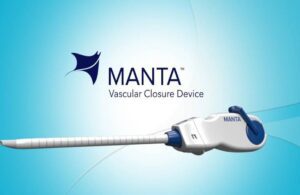
Teleflex
(NYSE: TFX)
announced today that it enrolled the first patient in a clinical registry evaluating its Manta vascular closure device (VCD).
The company aims for the registry to examine and collect data on outcomes of contemporary on-label use of Manta in standard of care transcatheter aortic valve replacement (TAVR) procedures. It includes appropriate patient selection and proper vascular access.
Wayne, Pennsylvania-based Teleflex offers Manta as the first commercially available biomechanical VCD for large-bore femoral arterial access site closure. The technology offers an alternative to cut-down and suture-mediated closure in large-bore procedures.
Since its first implantation in 2014, Manta received CE mark in 2016 and FDA approval in 2019. Teleflex said studies of Manta reached over 10,000 patients, with 150,000 units sold globally.
The ACCESS-MANTA registry aims to enroll at least 250 patients across 15 major TAVR institutions in the U.S. and Canada. It expects to employ the primary objectives of safety and effectiveness. Teleflex defines safety as VCD large-bore access ssite-related major and minor vascular complications within 30 days of the TAVR procedure. Teleflex measures effectiveness by time to hemostasis or elapsed time between Manta deployment and arterial hemostasis.
According to a news release, the study also looks at technical success, treatment success, ambulation success, discharge readiness and procedure time.
“The Manta device demonstrated those attributes in the pivotal SAFE MANTA IDE clinical trial,” Dr. Christopher Buller, Teleflex interventional medical director, said. “However, TAVR practice has since evolved to embrace routine access site imaging, awake procedures, somewhat smaller delivery systems and sheaths, lower-risk patients, and considerably higher per-operator experience. The ACCESS-MANTA registry will allow us to understand the degree to which these changes, coupled with a dedicated device that is optimally deployed, may improve large bore outcomes.”